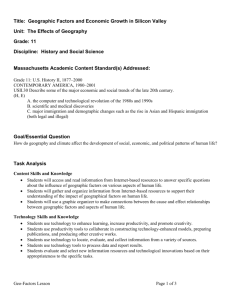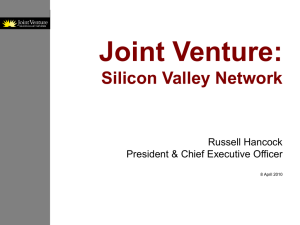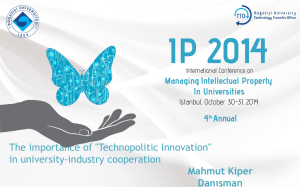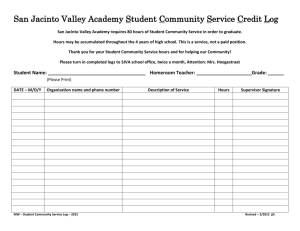What are we organising in Silicon Valley?
advertisement
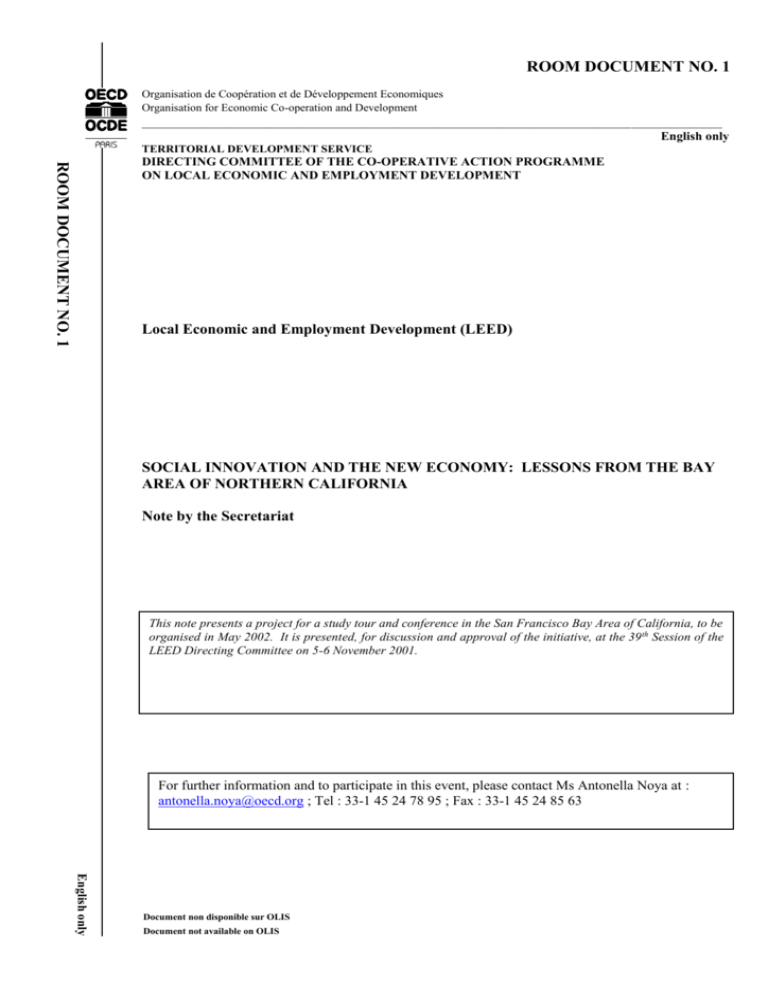
ROOM DOCUMENT NO. 1 Organisation de Coopération et de Développement Economiques Organisation for Economic Co-operation and Development __________________________________________________________________________________________ English only TERRITORIAL DEVELOPMENT SERVICE ROOM DOCUMENT NO. 1 DIRECTING COMMITTEE OF THE CO-OPERATIVE ACTION PROGRAMME ON LOCAL ECONOMIC AND EMPLOYMENT DEVELOPMENT Local Economic and Employment Development (LEED) SOCIAL INNOVATION AND THE NEW ECONOMY: LESSONS FROM THE BAY AREA OF NORTHERN CALIFORNIA Note by the Secretariat This note presents a project for a study tour and conference in the San Francisco Bay Area of California, to be organised in May 2002. It is presented, for discussion and approval of the initiative, at the 39 th Session of the LEED Directing Committee on 5-6 November 2001. For further information and to participate in this event, please contact Ms Antonella Noya at : antonella.noya@oecd.org ; Tel : 33-1 45 24 78 95 ; Fax : 33-1 45 24 85 63 English only Document non disponible sur OLIS Document not available on OLIS ROOM DOCUMENT NO. 1 Introduction The LEED Programme has developed a multi-year programme of work on social innovation and, in April 2000, launched the Forum on Social Innovations [DT/LEED/DC(2000)3/REV1]. This forum was designed to increase awareness amongst its Delegates and Partners that social innovation is a key element for sustainable economic progress and, therefore, to disseminate best policies and practices on social innovations. At the first stage of the programme, several events took place: To define Social Innovation (Washington, DC, April 2000); To analyse how the Non-profit sector is helping to foster and implement social innovation (Washington, D.C, September 2000) and to examine how corporate social responsibility can contribute to creating new relationships between business, stakeholders and territories (Paris, November 2000). During the second stage of this programme, LEED will analyse a number of major social innovations in OECD Member countries, which have been selected as a result of exploratory work carried out by the LEED Secretariat, aiming at identifying the most interesting and promising social innovations [DT/LEED/DC(2000)5]1. The LEED Secretariat will analyse the emergence of social enterprises (December 2001, Trento, in partnership with the University of Trento); Individual Development Accounts, an innovative financial tool for low-income people (April 2002, Ontario, Canada) [DT/LEED/DC(2001)19], and will tackle the issue of the role of social innovation in a technologically innovative environment such as Silicon Valley (May 2002, California, USA). This document will first of all give a brief overview of the main features of Silicon Valley and the challenges it faces. Secondly, it will present the main success factors of the region’s economic development. Thirdly, it will draw attention to a few social innovation tools in Silicon Valley, such as the social entrepreneurship and the venture philantrophy. Finally, it will present the two initiatives that will be organised in this region next Spring: a study tour and a conference. 1 A multidisciplinary team, composed of the Secretariat, experts and practitioners, put together a questionnaire, which was submitted to national experts and local organisations in several OECD member countries. As a result of this exploratory work, one hundred innovative experiences were selected on the basis of the 5 criteria against which social innovations are assessed: - New actors, products or services (e.g. identification of any new social needs), new processes (e.g. a new form of community participation) or a combination of objectives (e.g. a new integrated programme). - Social impact, such as welfare enhancement or empowerment. - Territorial impact, such as a new form of collaboration between territories. - Territorial spin-off (potential for transfer elsewhere). - Sustainability (strong probability of a long life). This work also resulted in the identification of seven core themes: - Innovations in Access to Capital - Employment, Targeting, Insertion - Innovations in Governance, Accountability, Responsibility and Evaluation. - Social Cohesion in the New Economy. - Innovative Services and Social Enterprises. - Indigenous Peoples’ Development. 2 ROOM DOCUMENT NO. 1 The Bay Area of Northern California: success and challenges. The Bay Area of Northern California, best known as Silicon Valley, (even if geographically Silicon Valley does not cover the entire region) is the acknowledged world leader of the New Economy. Silicon Valley is the area where much of the high-technology development has taken place along the south side of the San Francisco Bay. It includes Redwood City, Menlo Park, Palo Alto, Mountain View and San Jose (and Stanford University). The Bay Area is a somewhat larger area that encompasses San Francisco and Oakland, including the University of California at Berkeley. Source: Saxenian, A.L, (1994) Regional Advantage. Culture and Competition in Silicon Valley and route 128, Harvard University Press, Cambridge, Massachusetts, USA. 3 ROOM DOCUMENT NO. 1 Box 1. Characteristics of Silicon Valley The total area of the region measures 1500 square miles, with a population of more than 2.5 million (this region has more residents than 18 US States). It has 1.35 million jobs and a multiethnic composition (48% White, 24% Hispanic, 24% Asian/Pacific islanders, 4% African American). Silicon Valley was home to 48 of the fastest-growing high-tech companies in the United States in 2000. In Silicon Valley 40% of employment is in the seven principal industry clusters.2 Although technology companies exist throughout the Bay Area, Silicon Valley is distinctive for its concentration of technology-related employment. The region is two and a half times more concentrated in technology employment than any other high technology region in the USA . The region is exceptionally productive compared to the rest of the nation: value added per employee is double the national average. In 2000, the region’s average wage increased in real terms from $60,800 to $66,400. This increase compares to a national increase of 2% to $36,200. Average wages in industry clusters increased 20%: wages in other industries increased by 1%. (Joint Venture Silicon Valley, 2001). In spite of the crisis that has recently hit the region3, Silicon Valley continues to lead the world in the fields of technology and various other high-tech innovations. Being the centre of technological innovation has brought enormous economic benefits and wealth to the region, as well as international interest in attempting to replicate the Silicon Valley model. On the other hand, this success has not raised everyone’s standard of living and has brought in its wake a host of challenges for the housing market, the transportation system, the environment, educational capacity and the social and community fabric. Today, Silicon Valley is faced with serious problems which stem from this extremely rapid growth (a soaring cost of living; a severe housing shortage; traffic congestion; urban sprawl; environmental stress and widening socio-economic disparities). Governments, non-profit organisations and the private sector have begun to respond to these challenges with imagination, aiming at making this dynamic economy more sustainable, addressing the potential trade-offs between economic growth and the quality of life and wanting to ensure opportunities for the entire community. 2 The principal clusters in Silicon Valley are : computers/communications ; semiconductors/semiconductor equipment ; software ; bioscience ; defense/space ; innovation services ; professional services. 3 Since 2000 the US slowdown has hit Silicon Valley harder than any other US State. In 2001 there have been 106,843 job losses compared with 14,298 last June and 42,366 for the whole of last year. These redundancies have hit not only technology and manufacturing companies, but also a number of other industries. In this context, the drop in the Nasdaq index, which sent thousands of new companies into bankruptcy and meant the loss of jobs for thousands of people, exacerbated an already fragile situation. 4 ROOM DOCUMENT NO. 1 Some positive results are being achieved, others still need to be attained. The region’s main stakeholders consider that social innovation has an essential role to play to make the area more habitable for all residents. Innovative initiatives are developing in the region to reduce inequalities and the side effects of this successful development model. Among these initiatives, the rise of social venture capital, (venture philantrophy), the development of social entrepreneurship and corporate social responsibility are interesting developments to look at in their attempts to build socially and economically sustainable communities in the region. What makes Silicon Valley, Silicon Valley? The many reasons for the success of the region are fairly well-known. They can be seen as a powerful “cocktail” of different factors resulting in a “Silicon Valley culture” which attracts entrepreneurs and make things different from elsewhere (Saxenian, 1994; Kehoe, 1997, Lewis, 1999, Hiatt, 1999). “The beauty of Silicon Valley is that the culture and the structure reinforce each other” (Saxenian, 1994). Box 2. The culture of Silicon Valley (main ingredients) 1. Tolerance of failure : Silicon Valley recognises that failure is an integral part of business life. 2. Risk-seeking : a large share of the general and business population is prepared to risk in engaging in new ventures. 3. Reinvestment in the region: most of the money made out of the technology industry goes straight back in, either via people starting their own companies or via “business angel” investors. 4. Enthusiasm for change: A popular saying in Silicon Valley is “Either we obsolete ourselves, or the competition will”. Virtually every big firm in Silicon Valley is a spin-off from another one. 5. Promotion on merit: One of Silicon Valley’s secret weapons is openness to immigrants and to women. Age and experience, which elsewhere get people promoted, are of no help in the valley. 6. Obsession with the product: Silicon Valley’s obsession with “the cool idea” keeps it ahead of the competition. 7. Collaboration: Staff are borrowed, ideas shared, favours exchanged. 8. Variety: Despite their common culture, Silicon Valley companies come in all shapes and sizes. The sheer variety of companies in Silicon Valley gives the place a better chance of survival. 9. Anybody can play: In Silicon Valley most people believe that they too have a chance of becoming rich4. Together with culture, another element has a central role in Silicon Valley’s economic development model - namely its social capital. Steve Cohen and Gary Fields, from the University of Berkeley, have carried out one of the most appropriate analysis. 4 This box has been elaborated on the basis of a survey of Silicon Valley published in 1997 by the Economist “Future perfect” , March 29th 1997 5 ROOM DOCUMENT NO. 1 These authors consider that Silicon Valley is built on a kind of social capital, different from Putnam’s concept of social capital5, which refers to networks of civic engagement that facilitate the activities of politics, production and exchange. In Cohen’s and Fields’ views, the competitiveness of Silicon Valley is less a function of trust, reciprocity and networks of civic engagement but more the outcome of real historical events and the partnerships, business culture, organisations and institutions resulting from this history. (Cohen, Fields, 1999). The network environment in Silicon Valley is a process of cumulative causation. It is the outcome of historically-conditioned, specifically-chosen collaborations between individual entrepreneurs, firms and institutions focused on the pursuit of innovation and commercialisation. They are not dense networks of civic engagement, but focused, productive interactions among the following social institutions and entities: Box 3. The social capital of Silicon Valley (main ingredients) 1. The great research universities -- Stanford, UC Berkeley and UC San Francisco (UC Medical School). 2. US government policy, in the early phases of microelectronics and computer networking - both as a sponsor of University research and, critically, as the lead-user. 3. Venture capital firms. What distinguished this industry from venture capital in other parts of the country was the fact that venture capitalists in Silicon Valley invariably had had careers with technology firms in the region. As a result, Silicon Valley venture capitalists understood the technical dimensions of the business far better than their Eastern counterparts, 4. Law firms 5. The leading figures in University engineering departments venture firms, law firms and operating firms in Silicon Valley. 6. Stock options. Employees (not counting the firm’s “founders” and CEO) often hold options and shares amounting easily to 10 or 15% (or more at the early stages) of a firm’s capital value. 7. The important characteristics of the Silicon Valley labour market, which define the Valley’s particular brand of social capital. Among these characteristics are: first of all there is no stigma in leaving a large and very successful company to launch a start-up. Second there is rapid turnover. This has many consequences, one of which is technology diffusion. Third is recruitment of talent, especially scarce technical and entrepreneurial talent, from literally the entire world. To meet the needs of their clients, Silicon Valley law firms have developed a substantial capability -- sometimes in-house, sometimes networked -- in immigration law. 8. The specific nature of the industrial activities that shape the region’s social capital, valuing and strengthening some kinds of social structures compared to others, as well as defining its industrial specialisation (Cohen and Fields, 1999). This list and the analyses presented by Cohen and Fields, suggest that in Silicon Valley deep-seated forms of social engagement have been secondary in the area’s economic success. 5 In his book “Making Democracy Work” Putman considers that social capital refers to the features of social organizations that facilitate coordination and cooperation for mutual benefits. 6 ROOM DOCUMENT NO. 1 This result has been confirmed by a recent analysis (The Social Capital Community Benchmark Survey)6 on the situation of social capital (Putnam) in Silicon Valley which showed a weakness in social ties in the region. Box 4. The Social Capital Community Benchmark: main results In a place where business and technology networks are strong, the personal ties that bind people together and to the community are weak. Residents with household incomes of $ 30,000 participate in less informal socialising than those with household incomes of $ 75,000 and more. Residents give less of their time and resources to the community than in other parts of the country, despite the tremendous wealth amassed here over the past decades. The region is diverse in the number and variety of religious communities with which residents identify, but overall, residents are less involved in faith communities than in other parts of the country. The region has a higher percentage of immigrants than in the national sample (16 percent versus 5 percent), and this is reflected in different rates of participation in the political process. While social ties and community engagement are weak, people tend to trust each, other-including people from other ethnic or life-style backgrounds. - Overall social trust and inter-racial trust are higher here than in comparable communities. - People are more likely to be friends with individuals of a different race, or have homosexual friendships. Economics is the great divider in the community. Trust, civic engagement, and other social ties are positively associated with the quality of life. Overall, the region is characterised by weak ties but positive social and inter-racial trust, and a unique set of challenges for community building. - Work demands are a greater barrier to civic engagement here, but workplaces are also a rich mixture of diversity and innovation that might be "recycled" to the community - Civic and social connections “sort” people by their economic class and there is a need to address the social capital equivalent of a "digital divide". - Faith communities can play a greater role as incubators for social capital. - New "social architectures" will be required to build community. 6 The survey can be read in the Community Foundation Silicon Valley’s website (www.cfsv.org) This study was directed by the John F Kennedy School of Governement at Harvard University and was sponsored by the Community Foundation SiliconValley and the Peninsula Community Foundation. 7 ROOM DOCUMENT NO. 1 There is virtually nothing in the history of Silicon Valley to connect its networks of innovation to a densely-connected civil society. Nowadays, connecting technological innovation and social innovation seems to be the priority in Silicon Valley and one of the most appropriate ways to build a sustainable development model. Can Silicon Valley be a leading region in terms of social innovation? Silicon Valley is a leading model for innovation and technologies and a successful economic development model. Nevertheless, the rapid growth in Silicon Valley, plus the crisis which recently hit the region, showed the limits of this development model and the important challenges to be addressed to create a better situation for all Silicon Valley’s residents and to foster and build stronger, more inclusive and more liveable communities. Among these challenges particular attention is being paid to quality of life issues (housing, environment etc.) to the problem of social exclusion - as Manuel Castell (1996) said: “the greater the importance of the networks, the greater the cost of exclusion”, to the problem of immigration (after the downsizing of a great number of start-ups and established enterprises). Increasing the community culture in the Valley through the connection of the existing social networks both to each other and with mainstream economic networks, is a goal that should be pursued by public, private and non profit stakeholders. In recent years, Silicon Valley has been the cradle of very promising social innovations, resulting from a combination of entrepreneurial skills, culture and social goals. This is mainly true for social entrepreneurship and for venture philantrophy (social venture capital), while for corporate social responsibility, this mix is less surprising and, somewhere, more traditional. Social entrepreneurship is an emerging field, which encompasses: Profit-making organisations that use their resources to address social issues creatively Non-profit-making organisations that assist individuals in launching their own small, forprofit businesses, otherwise known as micro-enterprises or self-employment Non-profit-making ventures that create economic value to fund their own programmes or to create employment and training opportunities for their client population Social entrepreneurs take innovative approaches to solving social issues, using traditional business skills to create social, rather than private value. They are committed to fostering innovation and to exploring new opportunities. Social entrepreneurship is the integration of social work, community economic development, or business development and requires new ways of thinking and new forms of governance. It is of growing importance in the region and is a powerful tool for creating a new entrepreneurial culture integrating community values in the Valley. Nevertheless, it is important to find new ways to develop and support the creation and spread of social entrepreneurship. 8 ROOM DOCUMENT NO. 1 Social venture capital (or venture philantrophy) is one very effective way to foster and sustain social entrepreneurship. Even if there is no consensus on a precise definition of venture philanthropy, this refers to the nonprofit sector’s application of certain practices used by venture capitalists when investing in new business ideas. Venture philantrophy adapts strategic investment management practices to the non-profit sector to build and strengthen organisations that are able to generate high social rates of return on the investments made in them. A hallmark of these strategic investment management practices is longterm partnerships and strategic management assistance to leverage and augment substantial financial investments. Venture philantrophy encompasses the methods of venture capitalism with the needs of the non-profit world. This can be of immense help for non profit organisations, not only in terms of the capital they receive, but in the possibility of benefiting from the help of professionals in managing their activity in a more entrepreneurial way in order to fulfil their social mission. It is the approach to philantrophy that emphasises organisational capacity building and the belief that grants to non-profit groups represent a form of investment. Venture philanthropists look for ways to be engaged appropriately in supporting the work of nonprofit organisations beyond simply providing funding. Investors make long-term funding commitments, closely monitor performance objectives through pre-defined measurement tools and jointly problem-solve with the non-profit leadership team on a regular basis. Box 5. Main features of venture philantrophy Active engagement by donors in the charity, whether through participating on the Board of Directors, volunteering on-site at the organisation, and/or encouraging others to support the cause or organisation. Focused financial commitment. This is often a multi-year commitment with expectations that specified results will be obtained or the support will lapse. Focused on solving a social problem, not treating the symptoms. Venture philanthropists support those organisations that are working to change to the self-sufficiency model. Driven by identifying measurable outcomes and holding charities to meet those outcomes. This field is booming and a number of social venture funds are spreading on the West Coast of the United States. In this area cross-fertilisation among technology leaders and non-profit organisations has been most vigorous. Venture philanthropists can impact causes they care about by investing in venture philanthropy. Non-profit organisations can improve their managerial skills with the help of venture capital investors. What are we organising in Silicon Valley? The LEED Secretariat is planning to organise two events that will focus on social innovation in California: 9 ROOM DOCUMENT NO. 1 1. A study tour of the Bay Area to see the efforts that local governments, enterprises and non-profit organisations are undertaking to manage, in innovative ways, the social challenges of high growth created by the New Economy. 2. A one-day conference, hosted by CFED, which will bring together politicians, public agencies, academics, philanthropists, non-profit directors and community leaders. The aim will be to engage in debates about the processes of social innovation as well as practical responses to ensure equity, inclusiveness and sustainability in a fast growth economy. These events will be organised with the Corporation for Enterprise Development (CFED), an American LEED Partner based in Washington and San Francisco and with other possible partners. This project has received the financial support of the German Marshall Fund of the United States, which has already financed a number of initiatives undertaken in the framework of the Activity 3 of the LEED Programme and of the Forum on Social Innovation. Steps are being taken to raise additional funds for these events. The study visit The study tour will take place over a period of three or four days and will focus on San Francisco, Oakland, San Mateo, San Jose, Palo Alto, and Berkeley. It will seek to engage political leaders at state, county, and city level in discussions on these issues and also to visit a number of local initiatives and institutions, which are playing an important role in the region tackling social challenges. At this stage it is envisaged to visit the following organisations: Joint Venture Silicon Valley (San Jose)7, Assets for All Alliance/Centre for Venture Philanthropy (San Mateo)8, Bay Area IDA Collaborative (Oakland)9, Berkeley Roundtable on the International 7 http://www.jointventure.org. Joint Venture is a regional, non-partisan voice and a civic catalyst for solutions to problems which impact all sectors of the community. Joint Venture brings together established and emerging leaders from business, labor, government, education and community organizations and involves citizens from throughout the region. 8 http://www.pcf.org The Foundation is one of the fastest growing community foundations in the country and currently stewards $450 million dollars in more than 535 charitable funds. In 2000, the Foundation and our donors awarded a record $65 million in grants to more than 1,250 nonprofit programs and organizations in the Bay Area and beyond. 9 http://www.ebaldc.org. EBALDC is a community development organization dedicated to the betterment of the East Bay Community, particularly the low income and Asian and Pacific Islander population, through development of physical, human, and economic assets for individuals and community organizations 10 ROOM DOCUMENT NO. 1 Economy/BRIE (Berkeley)10, Roberts Enterprise Fund11 (San Francisco), The IndUS Entrepreneurs (“TiE”)12, Community Foundation SiliconValley13, Entrepreneurs Foundation (Palo Alto)14 The Conference The conference will be a one-day event at the end of the study tour. This will be the occasion for delegates to debate and reflect upon the impressions and information gathered on the study tour with a wide variety of local actors – policymakers, practitioners, activists and New Economy leaders. They will focus both on the processes of social innovation and on practical responses to the impacts of rapid growth - in particular on growing wealth gaps, inequalities in education, housing access, economic opportunity and on the impacts on environment and culture. The conference will be structured to maximise discussion and exchange, both in plenary and small group sessions. A report of the proceedings will be published and widely disseminated. The objectives of the FSI study visit and the conference are to: Raise awareness of the social challenges associated with rapid growth regions in the New Economy. Stimulate learning by international policy-makers and practitioners on socially innovative projects and institutions that are tackling these social challenges. Identify policy needs, levers, and roles for public, private and non-profit stakeholders. Foster the exchange of best practices during the tour, the conference, and beyond. Enable international, particularly European, policymakers to learn how US society operates at a local level to bridge the social gaps that can be a result of rapid economic growth. A report will be published on both the main findings of the study visit and the conference by the LEED Secretariat. 10 http://www. brie.berkeley.edu 11 http://www.redf.org. The Roberts Enterprise Development Fund (REDF) works to raise standards of excellence and integrity in the non profit sector. REDF develops and implements innovative approaches to critical social issues , based on its experience investing in a portfolio of nonprofit-run social purpose in the San Francisco Bay Area. 12 http://www.tiesv.org/index.html. TiE is a global, not-for-profit organization dedicated to the advancement of entrepreneurship. The name reflects the Indus or South Asian origin of the individuals who chartered the organization. TiE's principle objective is to provide a platform on which entrepreneurs with roots and / or interest in India, Pakistan, Bangladesh, Sri Lanka and Nepal can share their ideas 13 http://www.siliconvalleygives.org. The mission of Community Foundation Silicon Valley is to build a strong community, linking people together in a larger vision of what can be accomplished in a united and integrated manner. CFSV serves as a leader, catalyst, and resource for philanthropy by making grants to outstanding organizations and projects and by providing services to donors. 14 http:// www.the-ef.org works to encourage the entrepreneurial) sector of the Silicon Valley and Bay Area to incorporate community involvement as a core element of startup companies. 11 ROOM DOCUMENT NO. 1 Conclusions Silicon Valley is an interesting place to discover and study not only in terms of technological innovation but also in social innovations. Social entrepreneurship and venture philantropy are developing in a very effective way to foster social cohesion and reduce inequalities. The study tour and the conference will provide an in-depth examination of the social innovations in the region and analyse how social innovations can be fostered and supported in the New Economy. 12 ROOM DOCUMENT NO. 1 BIBILIOGRAPHY Castell, M (1996) The rise of the network society, Volume I, Blackwell, USA. Cohen, S and Fields G (1999), Social capital and capital gains: an examination of social capital in Silicon Valley, California management review 41, n°2 Collaborative Economics,(1998) Giving Back, The Silicon Valley Way. The culture of giving and volunteerism in Silicon Valley, Report prepared for Community Foundation Silicon Valley, San Francisco, California, USA Dees, J. G (1998) ”The meaning of social entrepreneurship” http://www.gsb.stanford.edu/services/news/DeesSocentrepPaper.html Emerson, J and Twersky, F (1996) New social entrepreneurs: the success, the challenge and Lessons of non -profit Enterprise Creation, Roberts Foundation, Homeless Economic Development Fund, San Francisco, California. Hiatt, F (1999), At this point geography counts, International Herald Tribune, Thursday, October, 7, 1999 Hirschhorn J. S (2000), Growing pains. Quality of life in the new Economy. Report prepared for the National Governors Association, Washington Dc, USA Joint Venture Silicon Valley (2001), 2001 Index of Silicon Valley. Measuring Progress toward the goals of Silicon Valley 2010. Kehoe, L (1997), The Valley’s magic formula, Financial Times, Monday August 25,1997 Letts, C. W, Ryan W, Grossman A (1997) Virtuous capital: what Foundations can learn from venture Capitalists, in Harvard Business Review , March- April. Lewis, M (1999), The new new thing. A Silicon Valley Story, Norton, USA Saxenian, A.L (1994), Regional advantage . culture and competition in Silicon Valley and route 128, Harvard University Press, Cambridge, Massachusetts, USA 13
